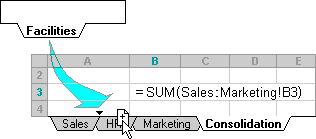A reference that refers to the same cell or range on multiple sheets is called a 3-D reference. A 3-D reference is useful and convenient way to reference several worksheets that follow the same pattern and cells on each worksheet contain the same type of data, such as when you consolidate budget data from different departments in your organization.
What do you want to do?
Learn about a 3-D refererence
You can use a 3-D reference to add up budget allocations between three departments, Sales, HR, and Marketing, each on a different worksheet, by using the following 3-D reference:
=SUM(Sales:Marketing!B3)
You can even add another worksheet, and then move it into the range that your formula refers to. For example, to add a reference to cell B3 in the Facilities worksheet, move the Facilities worksheet between the Sales and HR worksheets as shown in the following example.

Because your formula contains a 3-D reference to a range of worksheet names, Sales:Marketing!B3, all worksheets in the range are included in the new calculation.
Learn how 3-D references change when you move, copy, insert, or delete worksheets
The following examples explain what happens when you insert, copy, delete, or move worksheets that are included in a 3-D reference. The examples use the formula =SUM(Sheet2:Sheet6!A2:A5) to add cells A2 through A5 on worksheets 2 through 6.
Insert or copy If you insert or copy worksheets between Sheet2 and Sheet6 (the endpoints in this example), then Excel includes all values in cells A2 through A5 from the added worksheets in the calculations.
Delete If you delete worksheets between Sheet2 and Sheet6, then Excel removes their values from the calculation.
Move If you move worksheets from between Sheet2 and Sheet6 to a location outside of the referenced worksheet range, then Excel removes their values from the calculation.
Move an endpoint If you move Sheet2 or Sheet6 to another location in the same workbook, then Excel adjusts the calculation to include the new worksheets between them unless you reverse the order of the endpoints in the workbook. If you reverse the end points, the 3-D reference changes the endpoint worksheet. For example, say that you have a reference to Sheet2:Sheet6: If you move Sheet2 after Sheet6 in the workbook, then the formula will point to Sheet3:Sheet6. If you move Sheet6 in front of Sheet2, the formula will adjust to point to Sheet2:Sheet5.
Delete an endpoint If you delete Sheet2 or Sheet6, then Excel removes the values on that worksheet from the calculation.
Create a 3-D reference
-
Click the cell where you want to enter the function.
-
Type = (equal sign), enter the name of the function, and then type an opening parenthesis.
You can use the following functions in a 3-D reference:
|
Function |
Description |
|---|---|
|
Adds numbers. |
|
|
Calculates average (arithmetic mean) of numbers. |
|
|
Calculates average (arithmetic mean) of numbers; includes text and logicals. |
|
|
Counts cells that contain numbers. |
|
|
Counts cells that are not empty. |
|
|
Appends arrays horizontally and in sequence to return a larger array |
|
|
Finds largest value in a set of values. |
|
|
Finds largest value in a set of values; includes text and logicals. |
|
|
Finds smallest value in a set of values. |
|
|
Finds smallest value in a set of values; includes text and logicals. |
|
|
Multiplies numbers. |
|
|
Calculates standard deviation based on a sample. |
|
|
Calculates standard deviation based on a sample; includes text and logicals. |
|
|
Calculates standard deviation of an entire population. |
|
|
Calculates standard deviation of an entire population; includes text and logicals. |
|
|
Estimates variance based on a sample. |
|
|
Estimates variance based on a sample; includes text and logicals. |
|
|
Calculates variance for an entire population. |
|
|
Calculates variance for an entire population; includes text and logicals. |
|
|
Appends arrays vertically and in sequence to return a larger array |
-
Click the tab for the first worksheet that you want to reference.
-
Hold down SHIFT and click the tab for the last worksheet that you want to reference.
-
Select the cell or range of cells that you want to reference.
-
Complete the formula, and then press ENTER.
Create a name for a 3-D reference
-
On the Formulas tab, in the Defined Names group, click Define Name.
-
In the New Name dialog box, in the Name box, type the name you want to use for your reference. Names can be up to 255 characters in length.
-
In the Refers to box, select the equal sign (=) and the reference, then press BACKSPACE.
-
Click the tab for the first worksheet to be referenced.
-
Hold down SHIFT and click the tab for the last worksheet to be referenced.
-
Select the cell or range of cells to be referenced.











